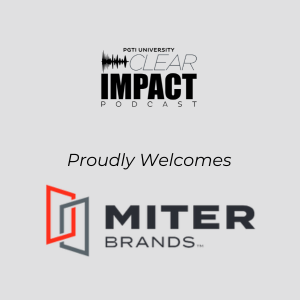Episode Transcript
[00:00:09] Speaker A: Welcome to the Clear Impact Podcast, brought to you by PGTI University. Thanks for joining us today. My name is Sherry Connor and I am your host.
So, good morning. We are here on the Clair Impact podcast and we are in a series called Windows and Doors 301 and we have Chris Wolf back in our studio. Welcome back.
[00:00:34] Speaker B: Thank you.
[00:00:35] Speaker A: Yeah, thanks for making some time for us. And so for anybody that may have missed the previous episode, can you just do like a quick introduction and just a recap your current role and responsibilities?
[00:00:46] Speaker B: Sure. I've been at the PGT brand for 14 years. Started in quality, went to manufacturing for a while, and then moved over to supplier quality. So I focus rarely just on the supplier interactions right now. So supplier quality and development manager and I deal with all the different suppliers from glass to hardware to coatings that we're talking about today.
[00:01:04] Speaker A: Wow. Just a small task.
[00:01:05] Speaker B: Yeah.
[00:01:06] Speaker A: And for which brands? Like all of them or just PGT or.
[00:01:09] Speaker B: Yeah, all of them. Right now, with the Mitre Brands acquisition, it's going to be throughout the whole company.
[00:01:13] Speaker A: Wow, that's a lot. Yeah, that's a big scope.
[00:01:16] Speaker B: It's exciting.
[00:01:17] Speaker A: It is exciting. And so today's conversation is around vinyl extrusions and capstock. And you are so, so great at explaining all of the aluminum coatings and paint versus powder coating versus anodized and all of that. With vinyl, it's a whole different animal. And we do about half and half in terms of PGT production, But for the vinyl, you know, we offer four different colors, basically, at least at pgt, but none of them are solid all the way. Like, the darker colors are not solid all the way through. And I get questions around this when we do tours. And so is vinyl painted or, like, how does vinyl become a color?
[00:02:03] Speaker B: So throughout the whole company, we've got all the different versions. So vinyl itself typically is extruded in a solid color. Normally at pgt, we've got white and tan. Those are the two colors. At Anlin, they also have Adobe and some other, you know, darker clay colors.
[00:02:18] Speaker A: Oh, yeah, they have like a dozen. But they also at Anlin, they have a paint booth, right? Yeah, because I've been there and they do their own.
[00:02:24] Speaker B: So that's where I'll talk a little bit about each of those different types of coatings.
[00:02:27] Speaker A: Okay.
[00:02:28] Speaker B: Um, you've got your raw material and then you can paint it. So that would be one. And typically, we talked on the last podcast about liquid paint and powder paint. You can't really get powder paint to stick and adhere Properly to vinyl. So you've got to paint with liquid. So that kind of turns that whole version on its head to say, okay, we have to go with liquid because of the conversion there. So it's going to be liquid coated. And they're going to paint at an Lynn. They're also painting vinyl at New South.
[00:02:50] Speaker A: Okay.
[00:02:50] Speaker B: So they've got painted vinyl windows up there as well. And then the next level, what you'd be looking at is probably a film or a laminated material.
[00:02:58] Speaker A: Okay.
[00:02:58] Speaker B: So that's going to be a thin film that's actually applied to the surface of the vinyl and then wrapped in certain areas. So it's a vinyl wrapped window.
[00:03:04] Speaker A: Okay.
[00:03:05] Speaker B: And you can get any of these interior and exterior, or both interior and exterior coated. And then the third color or third process is capstock, and that's what PGT is currently using. And Allen just started up using capstock as well. So with the extrusion process, just like with the aluminum process, you're putting material into an extruder. It's a slightly different thing. It's not exactly like the Play doh press for aluminum extrusion where you're pushing metal through a die. You're actually putting little pellets into a screw, and that heats it up and causes the pellets to melt and form together into that solid extrusion coming out. But that goes through a die very similar to the aluminum extrusion. And it goes through multiple different steps in that die process to get that final shape that comes out that we build windows and doors with.
[00:03:45] Speaker A: Right. And it's like a honeycomb. If anybody hasn't ever seen a corner sample, it's really interesting, like, oh, look at all those chambers in there. But that's where you get the better energy efficiency with vinyls. So.
[00:03:55] Speaker B: And you also build up some strength with that. They have to have the honeycombs or else the walls would fall in on themselves.
[00:03:59] Speaker A: Sure.
[00:03:59] Speaker B: So if you think about a honeycomb with bees, it's got to be built up with those, you know, hexagon shapes, or else you're not going to have a big enough support structure for the hive. And so that's really where the aluminum part of it comes from. A great solid product. But the vinyl product comes in a lot of energy efficiencies from those honeycombs and those air chambers inside. So these air chambers are slowing down the temperature difference from outside to inside.
[00:04:18] Speaker A: So first of all, why do we use capstock and why isn't it just a black frame or a Blonde or a bronze frame?
[00:04:23] Speaker B: That's a great question. With liquid paint, you're going to have a very thin coating on the outside. So it might be one to two thousandths of an inch of coating on top of the vinyl. If you take a screwdriver to it, that could skive or scratch through that painted coating. Now you can go back with a touch up pen and cover it, or you can go with the spray can or something like that. And you could possibly spray that and coat that, but you're going to still see sometimes some of that remnant of the scratch. With a film when you're laminating something, you're getting a thicker film thickness. But again, you could do the same thing. You scratch it and go through that film. It might be four or five thousandths of an inch thick. So that film thickness is thicker. Over time. There is an opportunity or possibility for that film to delaminate or come off if the process wasn't done properly at the supplier.
[00:05:04] Speaker A: Okay.
[00:05:05] Speaker B: So that's one of the risks with film. But then when you go to capstock, capstock is what we call co extruded. So we extrude the white vinyl and then we bring another second extruder in on one side. If we're doing a one side only, like an exterior only. If we're doing exterior and interior, they actually bring a third extruder in from the other side and do like a small extruder on those two sides and they'll extrude a different material. The main base material is PVC polyvinyl chloride. And then the sides are coming in with an acrylic material and those are colored. So that's where you're going to get your black or your bronze cap stock. That cap is a lot thicker. It's typically 8 to 12,000ths of an inch. And so you're going to get a lot thicker surface area there. And so if you did scratch something, something hit it, you know, you've got kids running through or dogs jumping up with their nails, it'll be less susceptible to scratch and show that white base underneath the color.
[00:05:50] Speaker A: Okay.
[00:05:51] Speaker B: So it's a little bit more durable and long lasting.
[00:05:53] Speaker A: Right. And why not just make it all black?
[00:05:55] Speaker B: That's a great question too. If you think about baking a cake, if you take a regular yellow cake, not a problem. I put it in together, put it in the oven, it's gonna bake a certain way, I've got a certain recipe. But as I start throwing stuff in there, maybe I throw some fruit in there, maybe I throw some chocolate chips. They're all going to bake differently. And when you're making a colored material, you're putting other colorant into it. So with black, usually they use something similar to a carbon black. Carbon is very dense and durable, but it doesn't change like the PVC does. So it's going to be like throwing chocolate chips or raisins into that cake. It's going to cook differently and it's going to process differently. So when they try to heat that up and extrude it, it's not going to come out consistent. So that's one of the challenges. The processing challenge is going to melt differently, it's going to process differently. And the other big challenge is that it's more costly. They can get white and tan PVC a lot cheaper than you can get the black colorants or the bronze colorants or changing to the other things. So that's why they do the cap. So they minimize how much cost goes into the entire extrusion and reduces how much is being spent for that whole thing from the die, from the pellets.
[00:06:54] Speaker A: Okay. Does it have anything to do with the heat and the way that vinyl absorbs the color, like the darkness of the color?
[00:07:03] Speaker B: Absolutely. If it was solid all the way through, it would still get hotter than just the capstock material, but it wouldn't be that much of a significant change. Typically, the heat is hitting wherever the sun's hitting it right now. It'll over time, absorb through that window. And so if it was all solid black or bronze, you would get an overall higher temperature from the window. But really, the surfaces are what's getting the most heat and absorbing that and changing. And we have looked at the material and had stabilized material for heat and then also for uv, for the chalk and fade. So the testing done from the suppliers, the testing done from the colorant manufacturers for that acrylic capstock material have gone through a lot of testing to make sure that we've got material that is solid and stable long term. In Florida, obviously, we've got requirements to, you know, last 20 years, 30 years in Florida with the high heat and UV. And so that material has been tested for that.
[00:07:48] Speaker A: All right, well, that helps me understand that a little bit better. So with vinyl, like, I know for pgt, we offer the four different colors. We have the white, we have the beige, and then we have the bronze with the white interior and the black with a white interior. And so can we do custom colors with vinyl or what if somebody really wanted the black Inside as well as the black outside. Like, how would we go about that? Or is that something that is even possible?
[00:08:17] Speaker B: So I think that's a big part of where the brands have their advantages. So PGT has capstock material with bronze and black as the offerings. They do have the ability to do black on both sides or bronze on both sides, or any combination of that. So you could do white exterior, black interior, or black exterior, white interior, or black on both sides. So you can do multiple different versions of black or bronze cap stock with custom colors. For pgt, we don't offer that, but there are other brands that do. So Allen paints their vinyl, and they can actually offer like a custom green inside and pink outside if you want. Actually did see an aluminum window that was painted pink and green, which was very odd to see an aluminum window. Window. Yeah.
[00:08:56] Speaker A: Oh, okay.
[00:08:57] Speaker B: But you can do that in vinyl if you've got one of the brands that will paint or laminate the material. So if you think about the wood grain for aluminum windows, totally different process for vinyl, but on vinyl, typically it's a wood grain laminate. So if you wanted wood grain for vinyl, you'd have to go laminate, and then you can get whatever the films are that that vendor provides the brand.
[00:09:15] Speaker A: Okay, so it's probably a pretty hefty upcharge, I would imagine.
[00:09:19] Speaker B: Yeah.
[00:09:19] Speaker A: Yeah. Okay.
[00:09:20] Speaker B: And I don't know the numbers on that one.
[00:09:21] Speaker A: I don't know.
Yeah, no, no, no. I mean, I've never even heard it offered, so I wasn't sure if that was something that we could do or not.
[00:09:28] Speaker B: And based on inventories, that's partly why it's an upcharge, because we're not going to stock a lot of those custom colors or custom wood grains because they're not asked for by their customers that often. And the white, the beige, the bronze, and the black are the highest runners for the PDD brand.
[00:09:42] Speaker A: Sure. Yeah, I know. That makes sense. Okay, well, thank you for explaining that.
The Clear Impact podcast is brought to you by pg.
We are a part of Mitre Brands, a family of leading window and door brands united by our passion for quality and relentless pursuit of 100%. One of the missions of Mitre Brands is to unite and deliver the finest customer experience possible across the nation. Our window indoor brands deliver regionalized expertise and products. Backed by a national company, PGTI University is here to educate you, our listener, so that you can be a more informed consumer of window indoor products.


